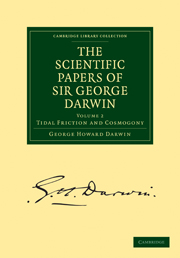Book contents
- Frontmatter
- PREFACE
- Contents
- Chronological List of Papers with References to the Volumes in which they are or probably will be contained
- Erratum in Vol. I
- TIDAL FRICTION AND COSMOGONY
- 1 On the Bodily Tides of Viscous and Semi-elastic Spheroids, and on the Ocean Tides upon a Yielding Nucleus
- 2 Note on Thomson's Theory of the Tides of an Elastic Sphere
- 3 On the Precession of a Viscous Spheroid, and on the Remote History of the Earth
- 4 Problems connected with the Tides of a Viscous Spheroid
- 5 The Determination of the Secular Effects of Tidal Friction by a Graphical Method
- 6 On the Secular Changes in the Elements of the Orbit of a Satellite revolving about a Tidally Distorted Planet
- 7 On the Analytical Expressions which give the History of a Fluid Planet of Small Viscosity, attended by a Single Satellite
- 8 On the Tidal Friction of a Planet attended by Several Satellites, and on the Evolution of the Solar System
- 9 On the Stresses caused in the Interior of the Earth by the Weight of Continents and Mountains
- INDEX
1 - On the Bodily Tides of Viscous and Semi-elastic Spheroids, and on the Ocean Tides upon a Yielding Nucleus
Published online by Cambridge University Press: 07 September 2010
- Frontmatter
- PREFACE
- Contents
- Chronological List of Papers with References to the Volumes in which they are or probably will be contained
- Erratum in Vol. I
- TIDAL FRICTION AND COSMOGONY
- 1 On the Bodily Tides of Viscous and Semi-elastic Spheroids, and on the Ocean Tides upon a Yielding Nucleus
- 2 Note on Thomson's Theory of the Tides of an Elastic Sphere
- 3 On the Precession of a Viscous Spheroid, and on the Remote History of the Earth
- 4 Problems connected with the Tides of a Viscous Spheroid
- 5 The Determination of the Secular Effects of Tidal Friction by a Graphical Method
- 6 On the Secular Changes in the Elements of the Orbit of a Satellite revolving about a Tidally Distorted Planet
- 7 On the Analytical Expressions which give the History of a Fluid Planet of Small Viscosity, attended by a Single Satellite
- 8 On the Tidal Friction of a Planet attended by Several Satellites, and on the Evolution of the Solar System
- 9 On the Stresses caused in the Interior of the Earth by the Weight of Continents and Mountains
- INDEX
Summary
In a well-known investigation Sir William Thomson has discussed the problem of the bodily tides of a homogeneous elastic sphere, and has drawn therefrom very important conclusions as to the great rigidity of the earth.
Now it appears improbable that the earth should be perfectly elastic; for the contortions of geological strata show that the matter constituting the earth is somewhat plastic, at least near the surface. We know also that even the most refractory metals can be made to flow under the action of sufficiently great forces.
Although Sir W. Thomson's investigation has gone far to overthrow the old idea of a semi-fluid interior to the earth, yet geologists are so strongly impressed by the fact that enormous masses of rock are being, and have been, poured out of volcanic vents in the earth's surface, that the belief is not yet extinct that we live on a thin shell over a sea of molten lava. Under these circumstances it appears to be of interest to investigate the consequences which would arise from the supposition that the matter constituting the earth is of a viscous or imperfectly elastic nature; for if the interior is constituted in this way, then the solid crust, unless very thick, cannot possess rigidity enough to repress the tidal surgings, and these hypotheses must give results fairly conformable to the reality. The hypothesis of imperfect elasticity will be principally interesting as showing how far Sir W. Thomson's results are modified by the supposition that the elasticity breaks down under continued stress.
- Type
- Chapter
- Information
- The Scientific Papers of Sir George DarwinTidal Friction and Cosmogony, pp. 1 - 32Publisher: Cambridge University PressPrint publication year: 2009First published in: 1908
- 1
- Cited by



